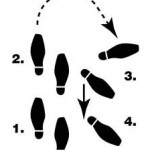Author Archives: Silver
Author Archives: Silver
Step Ten: Once you’ve mastered the dance, make it yours! The fundamentals of every dance do not change. That being the case how is it that some dancers can make it look like they’re inventing a dance on the spot? Those who are able to do that have mastered the fundamentals and, because of that mastery are able to innovate and make the dance their own.
This is the step that is generally fought tooth and nail in organizations. A good deal of lip service is given to the idea that we want employees to be innovative, to find new and better ways to do things. However, without a structure to support this decree, employees who have the courage to try are often maligned or, at the very least, discouraged from stepping outside the pre-existing boundaries of their jobs.
Some of these employees are what I call Changepreneurs.
Changepreneur™– someone who identifies opportunities within change, applies the necessary action to advance his/her ideas and assumes accountability for the inherent risks and outcome.
If you have Changepreneurs within your organization who are not nurtured, you will lose them. And, when they walk out your door the ideas that could take your organization to the next level leave with them. These are the employees who either join a competitor who will listen or they start their own companies.
Changepreneurs are never satisfied with the status quo. When something changes, not only are they the first to see the inherent opportunities, they are also the ones who act quickly and assume accountability for results. This is the kind of mindset every organization claims to want in their employees and yet, when those employees show up in the ranks, they are usually seen as threats. Phrases like, “Not a team player,” or “Doesn’t follow procedures,” are often seen in their employee evaluations.
Unlike Status-Quo employees, Changepreneurs thrive on change. They get bored with routine. The phrase, “If it ain’t broke, don’t fix it,” merely confuses them. They believe, “If it’s working well, why not make it even better?”
I am not saying that Status-Quo employees do not master the dance—they do! They master it so well that they don’t want to change one piece of it. When a twist on an established step is introduced, it disrupts their flow and they find the change unsettling and quickly reject it.
If you are a Status-Quo contributor, do not despair. There is great need for you in every organization. The Changepreneurs are the ones who shake things up with the end goal of improvement. They are builders, not maintainers like the Status-Quo employees. Once the Changepreneurs introduce change and generate forward momentum, they usually move on to the next thing, leaving the Status-Quo employees behind to clean things up and calm the waters. Even though you Status-Quo employees will complain about this, you wouldn’t have it any other way. There is nothing you enjoy more than creating order out of chaos.
Whether you are a Changepreneur or a Status-Quo employee (or somewhere in between) it is important for you to learn to dance with change because things aren’t going to slow down any time soon. We learn a new dance, master it and before we can enjoy our time on the dance floor, the music has changed and we’re obliged to learn a newer dance. The more quickly we can adapt, the easier and more productive our lives will be.
Step Ten comes as naturally to Changepreneurs as does breathing. For Status-Quo employees, it is a step that needs to be taken deliberately because you do not have a natural inclination to improvise. You are generally rule-followers and, in order to make a dance uniquely yours, you will have to step outside of the rules.
Every dancer has a style and you are no different. However, before you can put your unique mark on anything, you must first master the basics. Until you’ve done that, you will find little interest from others in your ideas for how to improve something you’ve not yet mastered yourself.
The steps of learning to dance with change:
One: Accept that which cannot be changed.
Two: Choose—will you dance or sit this one out?
Three: Determine how much of this new dance you already know.
Four: Determine your role—Lead or Follower?
Five: Focus on learning the new dance.
Six: Start with the frame—it’s everything.
Seven: If you step on your partner’s toes, apologize and keep dancing.
Eight: Find partners who are better at the dance than you.
Step Nine: Once you’ve mastered the steps—practice, practice, practice.
Learning anything new, whether it’s a dance, a new computer system or how to work with a new boss can be awkward at first. Think about the first time you tried to use a computer mouse. I couldn’t keep track of where the pointer was on my screen! I didn’t think I’d ever be able to control it and yet today I use it well without even having to think about what I’m doing.
In dance they call it muscle memory and it comes with practice—lots and lots of practice. In learning anything new, you cannot escape memorization. Once you’ve memorized the steps and you practice repeatedly, you cannot help but get better at whatever you are trying to learn.
We see examples of this every week on the show Dancing With the Stars. At the beginning of the weeks-long process, we look at some of the contestants and wonder how they will keep from embarrassing themselves once they perform. In rehearsals they trip, they fall, they cry and they get angry. Sound familiar? Don’t we all do some version of that when we are learning something new? Masters are those individuals who continue to get up, dust themselves off and try again. The before-and-after videos of the contestants are often amazing. It’s hard to believe we’re watching the same awkward dancers we saw at the beginning when, at the end, they dance so beautifully on stage.
I make a lot of speeches. For years I resisted the concept of practice. In my arrogance, I convinced myself that I was so good speaking “off the cuff” that I didn’t need to rehearse. Don’t get me wrong, I always prepared but I refused to practice, thinking that doing so would make my speeches seem stiff and too formal.
How wrong I was! There are stories I tell in my presentations that I have been telling for years. The more I repeat them, the better they are. I was, in effect, practicing in front of live audiences. I’ve stopped doing that. Today I spend hours alone practicing my talks. The more I practice in front of a mirror, the better they sound when I finally get up on that stage. And because I practice, my speeches sound relaxed and friendly, not stiff and formal, as I’d feared.
Think of some of the things you do well today as a result of hours of practice:
At first you were terrible. With practice you got better! Why is it, then, that we expect immediate expertise when adapting to a change?
When faced with learning something new, ask yourself, “What would I need to practice in order to get good at this?” Some things will be obvious, others not. For example, when dealing with a difficult co-worker or boss, what you may need to practice is responding to situations versus reacting. This involves proactively imagining a situation in which the other person does something that is certain to “set you off.” You then visualize how you will respond and you practice that response over and over until you know it like you know how to breathe. The next time that person does something that would normally aggravate you, you will then be able to respond calmly, just as you practiced. The alternative?—Skip the practice and do what you normally do—blurt out the first thing that pops into your head or say nothing and spend a sleepless night staring at the ceiling thinking, “I should have said this or I should have said that.”
Practice is the key to mastery and you have already mastered many things. Why stop there? Why not apply the same learning process that enables you to walk, use a computer and talk on the phone to the new challenges you face? In this way you will be practicing Dancing with Change!
The steps of learning to dance with change:
One: Accept that which cannot be changed.
Two: Choose—will you dance or sit this one out?
Three: Determine how much of this new dance you already know.
Four: Determine your role—Lead or Follower?
Five: Focus on learning the new dance.
Six: Start with the frame—it’s everything.
Seven: If you step on your partner’s toes, apologize and keep dancing.
Eight: Find partners who are better at the dance than you.
Master motivator Tony Robbins puts it this way, “If you want to be successful, find someone who has achieved the results you want and copy what they do and you’ll achieve the same results.” In other words, true to the principles of the Law of Attraction, you get more of what you focus on.
Too often we focus on looking good or on being better than others. In order to avoid feelings of vulnerability, we choose to interact only with those whose skills are inferior to ours. It’s easy to be the best in a sea of mediocrity.
As in any group, the dance community is comprised both of people who are committed to continual improvement and those who are content with “good enough.” There’s nothing wrong with the latter; it doesn’t, however, allow you to routinely exercise the “muscle” required to easily adapt to change.
“Good enough” is fine if you plan to dance with the same partner every time and you both agree to stay at that level. On the other hand, if you get into a situation where you are dancing with a different partner who is at a higher level, it could be hard for you to adapt to his/her style because you’ve been at “good enough” for so long. In a work situation, what this looks like is a team where some are pulling more of the weight than others and problems arise.
The best dancers, when they are trying to learn a new dance or get better at one they already know, look for someone who is extremely good at it and model what s/he does. Because they are dedicated to the goal of getting better, they willingly put themselves into a situation of vulnerability where they are not the best.
Surrounding yourself with those who have mastered what you are trying to achieve will ensure that you improve faster. As a bonus you will be exposed to new techniques and subtle nuances that are never seen in “good enough”.
Whenever you are faced with a change you can not or choose not to walk away from, learning what’s required to do this “new dance” is unavoidable. You can either learn everything the hard way (kicking and screaming) or be more like those dancers who are dedicated to getting better by volunteering to learn. The volunteers have learned the secret Tony Robbins talks about—they find someone to model.
A few years ago I was faced with a major change—arthritis in my left knee caused by surgery 30 years prior. It was so painful that when I turned over in my sleep at night I would cry out. Of course, being a bit of a “catastrophizer,” I envisioned all sorts of horrible outcomes and even began proactively mourning the things I was “sure” I’d never be able to do again (including dance).
Then I looked for potential solutions. I talked to my chiropractor. He told me what athletes do when they run into knee problems. At his urging, I began to do the same exercises to strengthen the muscles supporting my knee. Then I found Tami Lacey—an amazing trainer who modeled for me the exercises I could do to get really strong. (And then she stood over me to make sure I actually did them!)
Within two years I was able to hike to 8,000 feet in the Italian Alps and finish the 39-mile Avon Two-Day Walk for Breast Cancer. Imagine how different the results would have been if I had decided to model those who solved this same problem through pain medication or surgery. (Please—no emails! I understand that some situations are so bad that there are no other choices—luckily that wasn’t the case for me!)
I never needed to meet those “dance partners” who were better at the dance of recovery from knee problems than I was. As you move through this fast-changing world you have available to you many incredible models to help you dance with change. Find them. They are among your co-workers and friends, on the Internet, in your doctor’s office, in your schools and in your libraries.
We live in a remarkable time when Dancing With Change is not only possible, it can be quite easy—especially if you find and learn from partners who are better at the dance than you!
The steps of learning to dance with change:
One: Accept that which cannot be changed.
Two: Choose—will you dance or sit this one out?
Three: Determine how much of this new dance you already know.
Four: Determine your role—Lead or Follower?
Five: Focus on learning the new dance.
Six: Start with the frame—it’s everything.
Step Seven of Dancing with Change: If you step on your partner’s toes, apologize and keep dancing.
There are many reasons I chose the metaphor of Dancing with Change. One of the most important is that, when we first learn to dance, we expect to make mistakes. We know what we don’t know and therefore refrain from putting a load of pressure on ourselves to be experts from the start.
It seems to be a different story when it comes to work or tasks at home. It is always amazing to me how many of us (myself included) get frustrated to the point of anger (dare I say rage?) when we cannot quickly master something new. If you’ve ever wanted to throw your computer out the window then you know exactly what I’m talking about.
Somehow, we think there is something wrong with us if it takes awhile to learn anything new. When it comes to computers, for example, we say things like, “My 8 year-old nephew can do this; how difficult can it be?”
Here is where small children (say age 10 or under) have a major advantage over adults. Most of them have not yet been convinced that struggling to learn is a sign they are stupid. Most of them want to learn because it’s fun and a challenge.
In order to learn anything, it is necessary to make mistakes. Mistakes trigger a feeling of vulnerability, an extremely uncomfortable emotion and one we tend to avoid at all costs. The problem with this tactic is that avoidance costs us dearly. It keeps us from growing our skills, talent and knowledge. It keeps us from the level of mastery.
In order to master something you need to be willing to experience the vulnerability that comes with being in new territory. Ask anyone who is truly a Master how they became so and you will hear a litany of mistakes they made along the path to mastery. They will also tell you that they make new ones all the time.
New ones—that’s a clue. When I was a senior in High School I worked evenings and weekends at a department store. My boss was Mr. Keenan. I thought he was an incredibly smart man. One day I went to “confess” to Mr. Keenan that I had made a mistake. (I was raised Catholic; confession is in my DNA.) I proceeded to tell him how stupid my mistake was and how I couldn’t believe I had done such a dumb thing. I babbled on and on and on until he finally raised his hand in the universal signal for “Stop.” He said, “Silver, I don’t care if you make mistakes. That’s how you learn and it shows me you’re trying. Just don’t make the same mistake twice!”
I was flabbergasted. What? No punishment? No acts of contrition? Not even a single Hail Mary?!? This was the first time anyone had ever given me permission to make mistakes.
I thought Mr. Keenan was the wisest man in the world. (Side note: he was 25 years old at the time!)
Mr. Keenan, young though he was, knew what all good leaders do—that mistakes are a sign that your team members are trying. He was smart enough to tell me the boundaries—don’t make the same mistake twice—and to praise instead of shame. He also made it safe for me to come to him whenever I DID make a mistake.
One of the most important attributes you can have is a rare commodity—the courage to admit when you’ve erred, apologize and keep moving. Continuing to move is critical—can you imagine watching TV’s Dancing With the Stars and seeing each couple stop dancing every time they make a mistake? That would make the show at least six hours long! What every good dancer knows is: if you step on your partner’s toes, apologize and keep dancing. Most of the time, your partner is the only one who even notices the mistake. The same is true at work or at home. It’s appropriate to apologize to your partner(s) when you err; it’s not necessary to announce it to the world. Chances are, no one else even noticed.
The courage to keep dancing despite mistakes and obstacles and in the face of setbacks is a mark of greatness. Whether it’s Michael Jackson practicing over and over as he invented and then perfected the Moonwalk
or you at work struggling to learn a new process, persistence is key. Take it from wise “old” Mr. Keenan—mistakes are inevitable. What’s important is to learn from them, apologize to anyone whose toes got stepped on, and keep moving.
The steps of learning to dance with change:
One: Accept that which cannot be changed.
Two: Choose—will you dance or sit this one out?
Three: Determine how much of this new dance you already know.
Four: Determine your role—Lead or Follower?
Five: Focus on learning the new dance.
Step Six is:
Start with the frame—it’s everything.
In the dance community, you will often hear the term “frame” passionately discussed. According to Wikipedia, “Frame is the body shape maintained by dancers during partner dancing. Specifically, frame refers to the shape of the upper body of the dancers relative to the rest of the dancer’s body and the body of the dancer’s partner.”
When dancers have the frame right, the dance is easier to do and looks much better to those watching. 
What a frame is to a dancer, frame of mind is to you when you’re dancing with change. Frame of mind is the spirit with which you approach the change relative to both your internal mind-set as well as the position you take with the rest of your team.
When you have the right frame of mind, the change is easier to make and looks much better to those who are observing (like your boss!).
Frame of mind is a choice. No one can make you feel a certain way emotionally without you allowing it to happen.
One of the most significant findings in psychology in the last 20 years: we can choose the way we think.
Martin Seligman, Learned Optimism
A key challenge in implementing change is that those who came up with the idea for the change (Team A) usually have great enthusiasm for it while those who had it thrust upon them (Team B) do not. In fact, anyone on Team B who shows any enthusiasm at all for the idea is often treated as an outcast.
This situation is the sweet spot for a changepreneur™.
Are you a changepreneur™ or a “go along with the crowd” person? The former reaps untold opportunities and successes; the latter stays within a tight box, often one of dissatisfaction.
changepreneur™ n: someone who identifies opportunities within change, applies the necessary action to advance his/her ideas and assumes accountability for the inherent risks and outcomes.
Here is the frame of mind of a changepreneur™:
The old adage, “When the going gets tough, the tough get going” could have been written specifically to describe changepreneurs™. They are the people who are always looking for the silver lining in every cloud. They are those “lucky” individuals who consistently land on their feet. They seem to always be in the right place at the right time.
The Law of Attraction dictates that you get more of what you focus on. When you look at the frame of mind of a changepreneur™ versus a “go along with the crowd” individual you can see how well changepreneurs™ use this universal principle to its full advantage.
Frame is everything. The attitude you bring to change dictates how the dance will go. Whether it’s a low-key change reminiscent of the Viennese Waltz or a fast-paced one like the Lindy Hop, dancing well with change requires the right frame of mind.